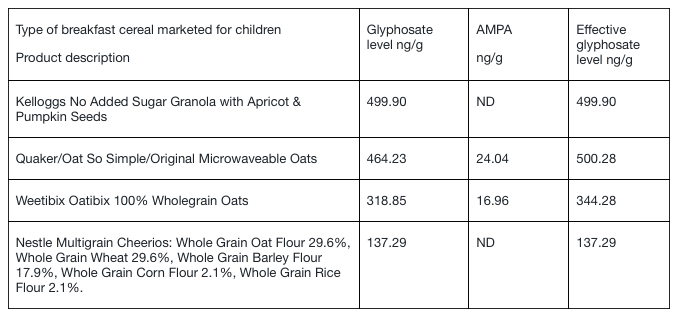Weed-killer for breakfast
Thu 2:06 pm +01:00, 2 Sep 2021
In August 2018, samples of four oat-based UK cereals were sent to the Health Research Institute Laboratories in the US following a newspaper report about US children eating weedkiller in their oat-based cereals. The following are the results of the analysis on the four oat-based cereals sent to the laboratory.
Dr John Fagan, the director of the lab, said:
“These results are consistently concerning. The levels consumed in a single daily helping of any one of these cereals, even the one with the lowest level of contamination, is sufficient to put the person’s glyphosate levels above the levels that cause fatty liver disease in rats (and likely in people).”
Washington State University (WSU) researchers have found a variety of diseases and other health problems in the second- and third-generation offspring of rats exposed to glyphosate. In the first study of its kind, the researchers saw descendants of exposed rats developing prostate, kidney and ovarian diseases, obesity and birth abnormalities.
Michael Skinner, a WSU professor of biological sciences, and his colleagues exposed pregnant rats to the herbicide between their eighth and 14th days of gestation. The dose – half the amount expected to show no adverse effect – produced no apparent ill effects on either the parents or the first generation of offspring.
But, writing in the journal Scientific Reports, the researchers say they saw “dramatic increases” in several pathologies affecting the second and third generations. The second generation had ‘significant increases’ in testis, ovary and mammary gland diseases as well as obesity. In third-generation males, the researchers saw a 30% increase in prostate disease – three times that of a control population. The third generation of females had a 40% increase in kidney disease or four times that of the controls.
More than one-third of the second-generation mothers had unsuccessful pregnancies, with most of those affected dying. Two out of five males and females in the third generation were obese.
Skinner and his colleagues call this phenomenon generational toxicology and they have seen it over the years in fungicides, pesticides, jet fuel, the plastics compound bisphenol A, the insect repellent DEET and the herbicide atrazine. At work are epigenetic changes that turn genes on and off, often because of environmental influences.
Roundup kills bumble bees
Although Mason mainly discusses the health impacts of glyphosate in her report to Tarazona, she did mention at least one disturbing environmental impact. In April 2021, the Journal of Applied Ecology published an article ‘Roundup causes high levels of mortality following contact exposure in bumble bees.’
The article’s abstract stated that pollinators underpin global food production but are suffering significant declines across the world.
It went on to say:
“Pesticides are thought to be important drivers of these declines. Herbicides are the most widely applied type of pesticides and are broadly considered ‘bee safe’ by regulatory bodies who explicitly allow their application directly onto foraging bees. We aimed to test the mortality effects of spraying the world’s most popular herbicide brand (Roundup) directly onto bumble bees (Bombus terrestris audax).”
The authors argue that Roundup products pose a significant hazard to bees, in both agricultural and urban systems and exposure of bees to them should be limited. They added that surfactants, or other co‐formulants, in herbicides and other pesticides may contribute to global bee declines.
They called for pesticide companies to release the full list of ingredients for each pesticide formulation, as lack of access to this information hampers research to determine safe exposure levels for beneficial insects in agro‐ecosystems.
Bayer’s multi-million-dollar headache
Mason asks Tarazona whether he has been following the trials against Monsanto in the US for concealing that its herbicide Roundup caused non-Hodgkin’s lymphoma.
She explains to him that three cases have been won against Monsanto/Bayer (Bayer bought Monsanto in 2018) and in 2021 there are thousands more awaiting to have their cases heard in court.
Attorney Robert F. Kennedy Jr said in 2018 that Bayer needs more than an aspirin to cure its Monsanto-sized headache.
Kennedy has been involved with some of these cases and has read enough of the scientific literature on glyphosate to conclude that there is cascading scientific evidence linking glyphosate to a constellation of other injuries that have become prevalent since its introduction, including obesity, depression, Alzheimer’s, ADHD, autism, multiple sclerosis, Parkinson’s, kidney and inflammatory bowel disease, brain, breast and prostate cancer, miscarriage, birth defects and declining sperm counts.
He added that strong science suggests glyphosate is the culprit in the exploding epidemics of celiac disease, colitis, gluten sensitivities, diabetes and non-alcoholic liver cancer which, for the first time, is attacking children as young as 10.
As if that is not worrying enough, Kennedy noted that researchers peg glyphosate as a potent endocrine disruptor, which interferes with sexual development in children. It is also a chelator that removes important minerals from the body and disrupts the microbiome, destroying beneficial bacteria in the human gut and triggering brain inflammation and other ill effects.
Although a Monsanto scientist claimed that glyphosate is excreted unchanged from the body, Mason cites a study by Ridley & Mirly (1988) which found bioaccumulation of glyphosate in bone, marrow, blood and glands (including thyroid, testes and ovaries) and major organs (heart, liver, lungs, kidneys, spleen and stomach). The paper was commissioned by Monsanto but was not published.
In a 1990 study conducted by Monsanto between 1987 and 1989 (again unpublished), glyphosate was found to induce a statistically-significant cataractous formation in the eyes of rats. Over the course of the study, cataract lens changes were seen in the low-, mid- and high dose groups in both male and female rats. The pathologist concluded that there was a glyphosate-treated related response for lens changes to the eyes.
Mason notes that the Assessment by the Rapporteur Member States tasked with risk assessing glyphosate have concluded that, based on the available ecotoxicological information glyphosate the current classification “Toxic to aquatic life with long lasting effects” should be retained and the current classification as “causes serious eye damage” (H318) should be retained.”
She therefore asks: how can a chemical like glyphosate still be on the market?
Mason notes that, according to the UN’s Global Chemicals Outlook II, glyphosate was at the top of the top ten products used on major crops in the United States, by volume, in 2016. Clothianidin (also manufactured by Bayer) is number ten.
She notes:
“No wonder Bayer doesn’t want to lose its licence for glyphosate or for clothianidin, a long-acting neonicotinoid insecticide that is very persistent in the soil. Both chemicals are on the market illegally thanks to the corrupt EU and US regulatory authorities.
And that is an issue which Mason draws Tarazona’s attention to and will be touched on in the second part of this article.
Readers can access Rosemary Mason’s new report, with all relevant references, here.
Recommended reading for Jose Tarazona and readers who want to dig deeper into the issues: all of Rosemary Mason’s previous reports can be accessed here.
*
Note to readers: Please click the share buttons above or below. Follow us on Instagram, @crg_globalresearch. Forward this article to your email lists. Crosspost on your blog site, internet forums. etc.
Colin Todhunter is an independent writer and analyst specialising in development, food and agriculture based in Europe/India.
He is a Research Associate of the Centre for Research on Globalization.












